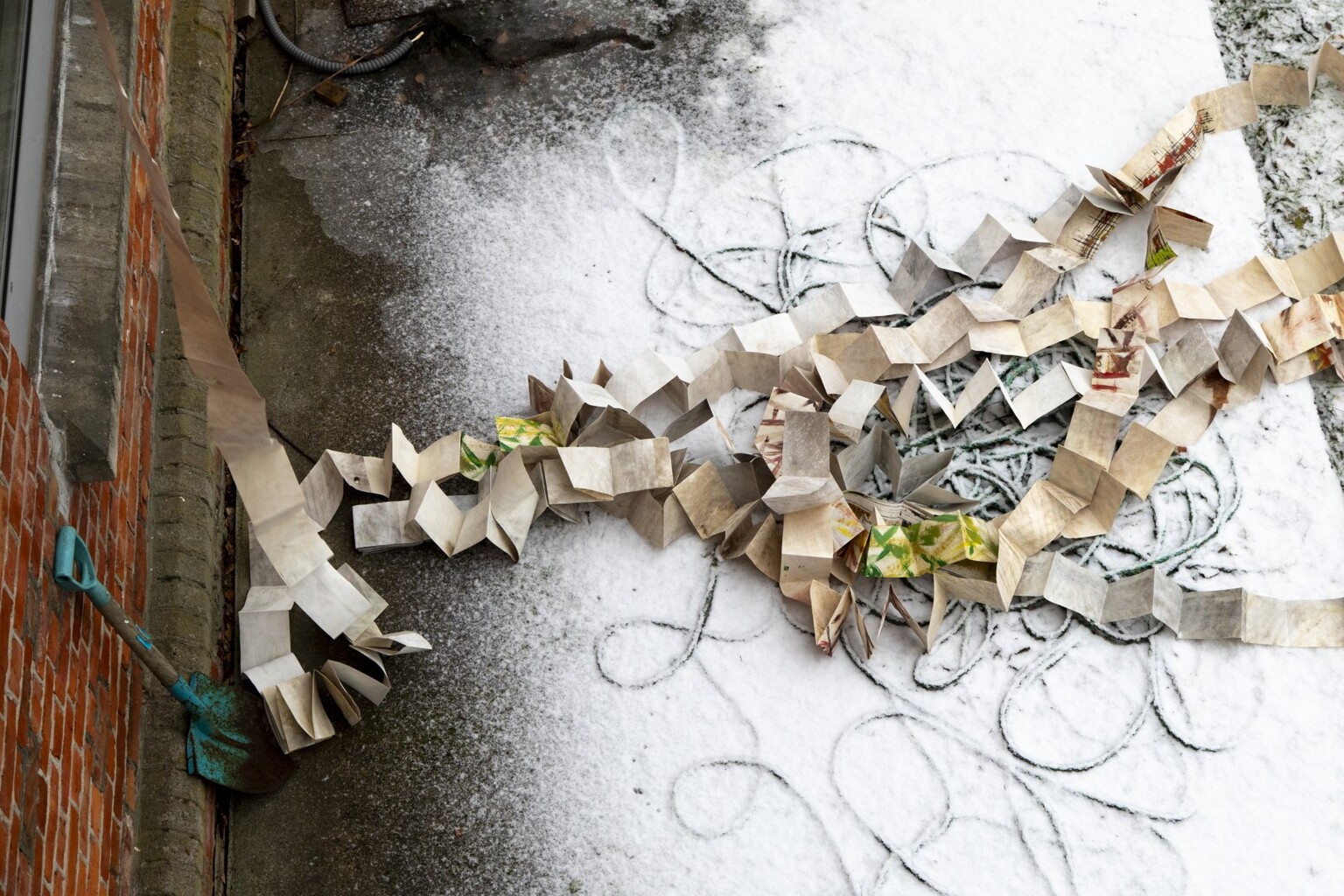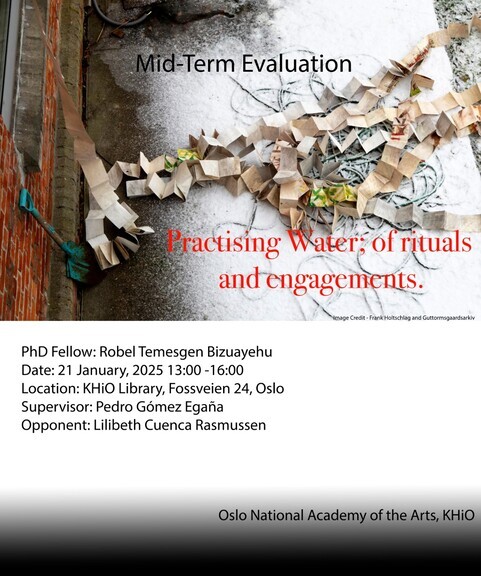Forelesning

Midterm Evaluation: PhD Fellow Robel Temesgen
PhD fellow Robel Temesgen presents his doctoral artistic research project Practising Water, of rituals and engagements.
Practising Water: of rituals and engagements studies the chronicles of Water, Spirituality, and the symbiotic relationships they devise as mode of communication and language. This encompasses the surrounding nature, including the human as an inevitable entity when discussing relations between water and spirituality. My research aims to identify and understand agencies' vocabulary in creating narratives that look into the water beyond its physical use and anthropogenic manifestations. It navigates relationships through the everyday accounts of habitats living off, by, with, or in surface water. This immersion seeks to understand how indigeneity engages water believed to have spiritual significance and how this relationality forges communication to accumulate epistemology while challenging epistemisde.
In this project, “water” specifically refers to surface water that flows within particular time-places. I do not intend to address water in its universal sense. Therefore, the pluriversality of water should be engaged from a localized perspective, particularly from an indigenous relatability. Hence, I departed from water close to my formation, the source point of the Blue Nile in the Gojam region, Ethiopia.
The epistemologies of a locality can challenge the pre-established concepts of epistemicide. This is evident in Walter Mignolo's decolonial theory, which thoroughly investigates pluriversality for an epistemic shift. He challenges epistemicide regarding knowledge structures molded by situated theories rather than academia, which sits in a position of authority and norm.
The following initial questions guide the research and artistic works: What does it mean when one claims to listen to the water or speak with water? What relevant vocabulary emerges when looking at various cultures and their relationship to bodies of water? What does this vocabulary reveal about the cultures I observe, the status of the body of water in question, and my position as observer, researcher, and artist? In my human desire for kinship with the earth and others, how can the spiritual, as an unearthly phenomenon, be situated? As the project progresses and brings forth critical questions alongside pre-formulated ones; researching, analyzing, and adopting forms of secrecy, care, fear and intensity require by spiritual relatedness become instrumental for both methods and findings. By adopting and initiating rituals and engagements across artistic instances, the project establishes a space for learning and knowing.
Program
13:00–13:15 - Coffee, meet and greet
13.15-13:20 - Welcome by Pedro Gómez Egaña.
13:20–14:05 - PhD fellow Robel Temesgen presents works and talks about his doctoral project
14:05-14:20 - Break
14:20-15:05 - Discussion between Lilibeth Cuenca Rasmussen, respondent, and Robel Temesgen, PhD fellow, Moderated by Pedro Gómez Egaña.
15:05-15:20 - Break
15:20-16:00 Questions and responses from the public moderated by Pedro Gómez Egaña.
Respondent
Lilibeth Cuenca Rasmussen, Professor, Performance and time-based art, Faculty of Fine Art, Music and design, University of Bergen
Supervisors
Main Supervisor: Pedro Gómez Egaña, Professor of Sculpture and Installation, Academy of Fine Art, KHiO
Second Supervisor: Inti Guerrero, Independent Curator
Robel Temesgen
Robel Temesgen (b. 1987) is a Ph.D. fellow in Artistic Practice at the Oslo National Academy of the Arts. He received an MFA from Tromsø Academy of Contemporary Art, University of Tromsø, Norway in 2015 and a BFA in Fine Art (Painting) from Alle School of Fine Arts and Design, Addis Ababa University in 2010. Robel’s work focuses on symbiotic relations and the languages around places, people, and spirits through painting, publication, and installation. His lengthy projects include Adbar, Addis Newspaper, and Practicing Water. Robel’s work has been widely exhibited on international platforms in solo and group shows, including Kunsthall Oslo (2023), Lingen Konsthalle, Lingen (2022), ARoS Museum, Aarhus (2021), Para Site, Hong Kong (2021), Kunsthall Oslo, Olso (2019), Circle Art Agency, Nairobi (2019), Addis Foto Fest, Addis Ababa (2018), Modern Art Museum, Addis Ababa (2018), Hamburger Bahnhof, Berlin (2017), Akademie der Künste, Berlin (2016), and Neue Nationalgalerie, Berlin (2014). He received several awards and fellowships, Lingen Art Prize (2022), Junge Akademie, Akademie der Künste, Berlin (2018), and IASPIS, Stockholm (2017). Robel is a Lecturer at Alle School of Fine Arts and Design, Addis Ababa University, and lives between Addis Ababa and Oslo.
Lilibeth Cuenca Rasmussens
Lilibeth Cuenca Rasmussens praxis is based on performance art, also transformed to different materials and medias as video, photography, sculpture and installations.
Cuencas productions involve the body, scripted texts, songs; composed music as well as intricate visual elements as costumes used as set design. She gathers, adapts, and universalizes her narratives in both a critical and humorous approach in regards to issues such as identity, culture, religion, gender and social relations.
Pedro Gómez-Egaña
tPedro Gómez-Egaña makes sculptures, immersive installations, phonographic pieces and films, also making use of different mediums such as performance, text and sound works. Central to his artistic approach is the performative aspect of sculpture, which he presents as dynamic, animated objects or as theatrical environments. His practice is motivated by technology and how it influences the ways in which we experience and understand time. His recent projects reconstruct and refer to historical examples of industrialization, presenting them as haunted and vulnerable. Drawing from both contemporary and historical intersections between science and the occult, Gómez-Egaña’s work also explores the relationship between technology and mysticism, and the emotional and spiritual undertones of digital culture.
